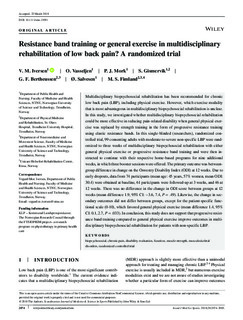| dc.contributor.author | Iversen, Vegard Moe | |
| dc.contributor.author | Vasseljen, Ottar | |
| dc.contributor.author | Mork, Paul Jarle | |
| dc.contributor.author | Gismervik, Sigmund Østgård | |
| dc.contributor.author | Bertheussen, Gro Falkener | |
| dc.contributor.author | Salvesen, Øyvind | |
| dc.contributor.author | Fimland, Marius Steiro | |
| dc.date.accessioned | 2019-02-13T13:22:27Z | |
| dc.date.available | 2019-02-13T13:22:27Z | |
| dc.date.created | 2018-10-01T08:49:28Z | |
| dc.date.issued | 2018 | |
| dc.identifier.citation | Scandinavian Journal of Medicine & Science in Sports. 2018, 28 (9), 2074-2083. | nb_NO |
| dc.identifier.issn | 0905-7188 | |
| dc.identifier.uri | http://hdl.handle.net/11250/2585257 | |
| dc.description.abstract | Multidisciplinary biopsychosocial rehabilitation has been recommended for chronic low back pain (LBP), including physical exercise. However, which exercise modality that is most advantageous in multidisciplinary biopsychosocial rehabilitation is unclear. In this study, we investigated whether multidisciplinary biopsychosocial rehabilitation could be more effective in reducing pain‐related disability when general physical exercise was replaced by strength training in the form of progressive resistance training using elastic resistance bands. In this single‐blinded (researchers), randomized controlled trial, 99 consenting adults with moderate‐to‐severe non‐specific LBP were randomized to three weeks of multidisciplinary biopsychosocial rehabilitation with either general physical exercise or progressive resistance band training and were then instructed to continue with their respective home‐based programs for nine additional weeks, in which three booster sessions were offered. The primary outcome was between‐group difference in change on the Oswestry Disability Index (ODI) at 12 weeks. Due to early dropouts, data from 74 participants (mean age: 45 years, 57% women, mean ODI: 30.4) were obtained at baseline, 61 participants were followed‐up at 3 weeks, and 46 at 12 weeks. There was no difference in the change in ODI score between groups at 12 weeks (mean difference 1.9, 95% CI: −3.6, 7.4, P = .49). Likewise, the change in secondary outcomes did not differ between groups, except for the patient‐specific functional scale (0‐10), which favored general physical exercise (mean difference 1.4, 95% CI: 0.1, 2.7, P = .033). In conclusion, this study does not support that progressive resistance band training compared to general physical exercise improve outcomes in multidisciplinary biopsychosocial rehabilitation for patients with non‐specific LBP. | nb_NO |
| dc.language.iso | eng | nb_NO |
| dc.publisher | Wiley | nb_NO |
| dc.rights | Navngivelse-Ikkekommersiell 4.0 Internasjonal | * |
| dc.rights.uri | http://creativecommons.org/licenses/by-nc/4.0/deed.no | * |
| dc.title | Resistance band training or general exercise in multidisciplinary rehabilitation of low back pain? A randomized trial | nb_NO |
| dc.type | Journal article | nb_NO |
| dc.type | Peer reviewed | nb_NO |
| dc.description.version | publishedVersion | nb_NO |
| dc.source.pagenumber | 2074-2083 | nb_NO |
| dc.source.volume | 28 | nb_NO |
| dc.source.journal | Scandinavian Journal of Medicine & Science in Sports | nb_NO |
| dc.source.issue | 9 | nb_NO |
| dc.identifier.doi | 10.1111/sms.13091 | |
| dc.identifier.cristin | 1616457 | |
| dc.description.localcode | © 2018 The Authors. Scandinavian Journal of Medicine & Science In Sports Published by John Wiley & Sons Ltd | nb_NO |
| cristin.unitcode | 194,65,20,0 | |
| cristin.unitcode | 194,65,30,0 | |
| cristin.unitname | Institutt for samfunnsmedisin og sykepleie | |
| cristin.unitname | Institutt for nevromedisin og bevegelsesvitenskap | |
| cristin.ispublished | true | |
| cristin.fulltext | original | |
| cristin.qualitycode | 2 | |

